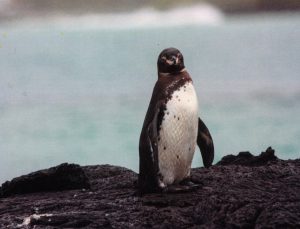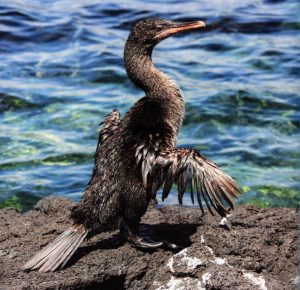The most notable endemic Galápagos sea birds are the Galápagos penguin (Spheniscus meniculus), the Flightless Cormorant (Nannopterum barrisi), and the Waved Albatross (Diomedea irrorata). These species of birds are found only on the islands of the Galápagos and exhibit very unique adaptations.
Galápagos Penguin:
These little penguins stand only slightly taller than one foot. That puts them in the category of among the smallest penguins. Most people are aware of the penguins found in Antarctica and elsewhere in the southern hemisphere, but the Galápagos species is the only one found in the northern hemisphere and is the only one that breeds within the tropics. They occur mainly in the cooler western waters of the archipelago in the islands of Isabela and Fernandina. Adults mate for life, and the total population is thought to number less than 1300 breeding pairs. During courtship they make sounds described as similar to the braying of donkeys.
As adults they are black above and white below with a stripe around the breast and on the face. Juveniles are grayer and without the white lines. An interesting behavior of these birds is that since the white front of their bodies is in sharp contrast with the black lava rocks that they frequent when standing, they are known to turn 180 degrees when approached so that they blend in with the lava.
These flightless birds swim rather slowly on the surface of the water but “fly” through the water at speeds of up to 25 miles per hour using their wings for propulsion and their feet for rudders. Galápagos penguins have adapted to both hot land and cool water environments, a situation much different from their southern relatives who only have to adapt to cold environments. They are surprisingly agile while walking on land and use their flippers and feet to hop from lava rock to lava rock, and they usually jump feet first into the water.
Flightless Cormorant:
The Galápagos flightless cormorant (Nannopterum harrisi) is the largest of the world’s 29 cormorant species and grows to be about three feet long. The adults are black above, brownish below, and develop brilliant turquoise eyes at maturity. They have long sinuous necks, a hooked bill, large, black-webbed feet, and sturdy black legs.
Flightless Galápagos Cormorant with Wings out to Dry (Purdom)
They derive their name from the fact that, unlike all other cormorant species, they cannot fly in the air. They have lost the large sternum and flight muscles of flying birds. This is likely due to the lack of land predators on the Galápagos Islands when the first cormorants arrived. Over time, probably not as long as one might think, the bird’s wings atrophied, and its legs got stronger in later generations. To say the wings became “useless” is not factual since the birds use them for balance as they hop about on land. Experts do not agree on whether or not they use the wings underwater when they are swimming after food.
This is not evolution by natural selection. The adaptive loss of wing flight function did not make a new kind of bird. Natural selection did not cause this change because nature is stupid and cannot select anything. This was an internal genetic change allowed for by the original genetic makeup that God placed in the birds in the beginning.
The cormorants of the Galápagos do not venture away from land more than 100 yards or so and can get sufficient food within that range to allow for about 700 pairs of birds to thrive there. However, it seems that it is imperative that authorities must be able to keep to a minimum the animals that would disrupt the lives of these birds (like dogs) in order to allow these sea birds to survive in their flightless state.
The way that the flightless cormorants get their food is noteworthy too. While on the surface of the ocean they swim low in the water, using their webbed feet for propulsion. When food is in the area, they make a short leap up out of the water and then dive down after the prey. This unique motion has been described as a “jackknife” dive.
Waved Albatross:
The endemic waved albatross (Diomedea irrorata) is the largest Galápagos bird and breeds only on the island of Espanola. There are about 12,000 pairs, and they grow to be about three feet long with a wingspan of almost eight feet. The wings and tails of the birds are brown, but pale underneath with gray, wavy barring. This is how they get their name as “waved.” They have a white neck with a cream-colored nape. Their bills are caterpillar yellow and are hooked downward.
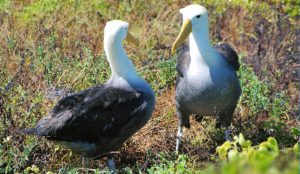 Pair of Waved Albatross (Davis)
Pair of Waved Albatross (Davis)
It requires about sixty days for a single laid egg to hatch and 24-30 weeks after that the young bird is ready to attempt flight. To do so it must clumsily stumble over to the edge of an Espanola cliff. After some trepidation it leaps into the wind and elegantly flies away from the island not to return for at least four years while it inhabits the environs of Ecuador and Peru.
The mating ritual of the waved albatross is described as something for great entertainment by observers. The male and female, who mate for life, face each other as they begin a series of amazing movements and gestures described as: “’bill-circling,’ ‘sky-pointing,’ ‘the shy look,’ ‘the drunken swagger,’ ‘bill clapping,’ ‘mooing,’ and ‘gaping.’” * What a sight that must be!
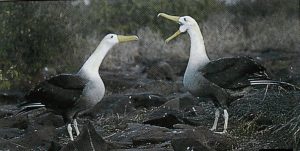 Waved Albatross Mating Antics-1 (Jackson)
Waved Albatross Mating Antics-1 (Jackson)
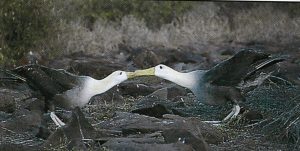 Waved Albatross Mating Antics-2 (Jackson)
Waved Albatross Mating Antics-2 (Jackson)
Another unusual behavior of the waved albatross is adults can manufacture a substance called “chick oil” from the food they eat. It is transferred from a part of the stomach to the chicks for sustenance. The mouth-to-mouth transfer soon results in about four pounds of oil in the gullet of a chick. This makes a “balloon” of the ugly chick but results in rapid growth of its flight feathers.
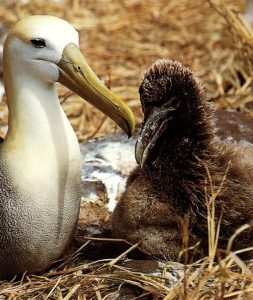 Adult & Chick Waved Albatross (Fitter)
Adult & Chick Waved Albatross (Fitter)
These Galápagos sea birds are amazing examples of God’s limitless creative ability!
J.D. Mitchell
Related Articles:
*Descriptors from: Horwell & Oxford, Galápagos Wildlife-A Visitor’s Guide, Bradt Publications, 1999, p. 6
